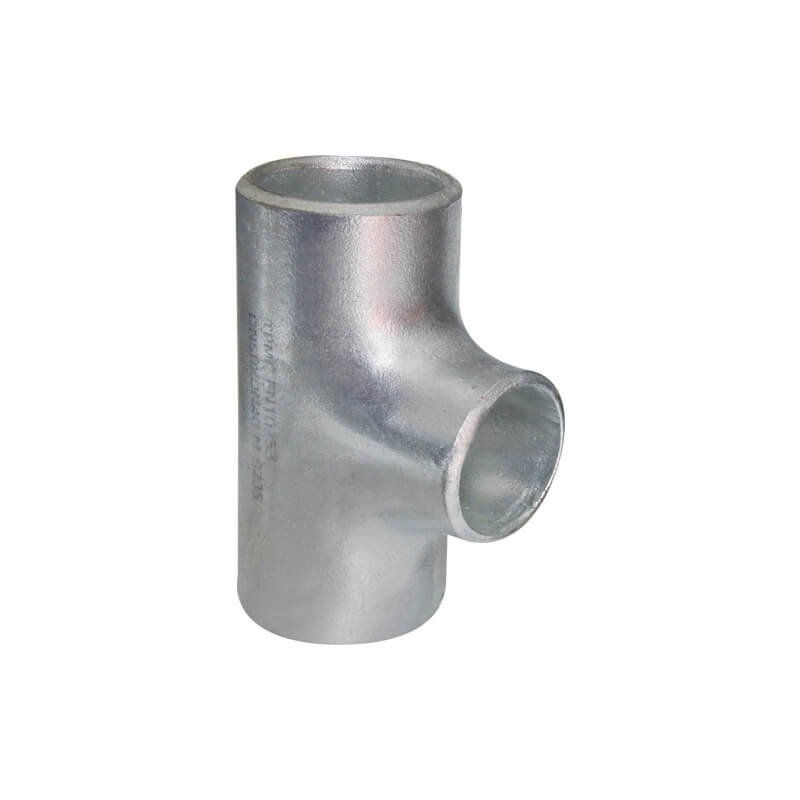Mail : sales@hariomsteel.com
Reducing Tee

The reducing tee is a critical fitting in piping systems designed to connect three pipes of different diameters, allowing fluid to flow from one main pipe into two smaller branches. This fitting is essential for applications where changes in pipe size are needed while maintaining a smooth transition and efficient flow distribution. Reducing tees are widely used in industries such as water treatment, oil and gas, and chemical processing, where adaptable and versatile flow management is required.
Made from high-quality materials, reducing tees are built to withstand varying pressures and temperatures, ensuring durability and reliability in challenging conditions. The fitting's design helps minimize turbulence and pressure loss during fluid transitions between different pipe sizes. Adhering to rigorous industry standards like ASTM, ASME, and ANSI, reducing tees offer dependable performance and long-term service. Their robust construction and precise engineering make them ideal for applications requiring effective flow control and seamless integration of different pipe sizes.
Material Grades :
| Material Type | Grades |
|---|---|
| Carbon Steel | ASTM A 105/A694/ A350 LF3/A350 LF2 - F42, F46, F52, F56, F60, F65 |
| Stainless Steel | ASTM A 182 - F 304, 304L, 304H, 309S, 309H, 310S, 310H, 316, 316Ti, 316H, 316L, 321, 321H, 347, 347H, 904L |
| Duplex & Super Duplex | ASTM / ASME A/SA 182 - F44, F45, F51, F53, F55, F60, F61 |
| Nickel | 200, 201 |
| Monel | 400 |
| Inconel | 600, 601, 625, 800, 825 |
| Hastelloy | C-276 |
Reducing Tee Specifications:
| Specification | Details |
|---|---|
| Material | Carbon Steel, Stainless Steel, Alloy Steel (e.g., ASTM A234 WPB, ASTM A403 WP304, ASTM A420 WPL6) |
| Type | Reducing Tee Butt Weld Fittings |
| Temperature Range | -29°C to 593°C (-20°F to 1100°F) |
| Corrosion Resistance | High resistance to corrosion, suitable for various environments |
| Standards | ASTM A234, ASME B16.9, MSS SP-75 |
| Sizes | 1/2" to 48" |
| Applications | Pipeline Systems, Industrial Piping, Oil & Gas, Chemical Processing, Waterworks |
| Production Technique | Butt Welding |
Dimension Chart :

| Nominal Pipe Size | Outside diameter at bevel | Center-to-End | |||
|---|---|---|---|---|---|
| Run | Outlet | Run | Outlet | Run (C) | Outlet (M) |
| 1/2" | 1/4" 3/8" | 21.3 | 13.7 17.3 | 25 | 25 |
| 3/4" | 3/8" 1/2" | 26.7 | 17.3 21.3 | 29 | 29 |
| 1" | 1/2" 3/4" | 33.4 | 21.3 26.7 | 38 | 38 |
| 1 1/4" | 1/2" 3/4" 1" | 42.2 | 21.3 26.7 33.4 | 48 | 48 |
| 1 1/2" | 1/2" 3/4" 1" 1 1/4" | 48.3 | 21.3 26.7 33.4 42.2 | 57 | 57 |
| 2" | 3/4" 1" 1 1/4" 1 1/2" | 60.3 | 26.7 33.4 42.2 48.3 | 64 | 44 51 57 60 |
| 2 1/2" | 1" 1 1/4" 1 1/2" 2" | 73.0 | 33.4 42.2 48.3 60.3 | 76 | 57 64 67 70 |
| 3" | 1 1/4" 1 1/2" 2" 2 1/2" | 88.9 | 42.2 48.3 60.3 73.0 | 86 | 70 73 76 83 |
| 3 1/2" | 1 1/2" 2" 2 1/2" 3" | 101.6 | 48.3 60.3 73.0 88.9 | 95 | 79 83 89 92 |
| 4" | 1 1/2" 2" 2 1/2" 3" 3 1/2" | 114.3 | 48.3 60.3 73.0 88.9 101.6 | 105 | 86 89 95 98 102 |
| 5" | 2" 2 1/2" 3" 3 1/2" 4" | 141.3 | 60.3 73.0 88.9 101.6 114.3 | 124 | 105 108 111 114 117 |
| 6" | 2 1/2" 3" 3 1/2" 4" 5 | 168.3 | 73.0 88.9 101.6 114.3 141.3 | 143 | 121 124 127 130 137 |
| 8" | 3 1/2" 4" 5" 6" | 219.1 | 101.6 114.3 141.3 168.3 | 178 | 152 156 162 168 |
| 10" | 4" 5" 6" 8" | 273.0 | 114.3 141.3 168.3 219.1 | 216 | 184 191 194 203 |
| 12" | 5" 6" 8" 10" | 323.8 | 141.3 168.3 219.1 273.0 | 254 | 216 219 229 241 |
| 14" | 6" 8" 10" 12" | 355.6 | 168.3 219.1 273.0 323.8 | 279 | 238 248 257 270 |
| 16" | 6" 8" 10" 12" 14" | 406.4 | 168.3 219.1 273.0 323.8 355.6 | 305 | 264 273 283 295 305 |
| 18" | 8" 10" 12" 14" 16" | 457.0 | 219.1 273.0 323.8 355.6 406.4 | 343 | 298 308 321 330 330 |
| 20" | 8" 10" 12" 14" 16" 18" | 508.0 | 219.1 273.0 323.8 355.6 406.4 457.0 | 381 | 324 333 346 356 356 368 |
| 22" | 10" 12" 14" 16" 18" 20" | 559.0 | 273.0 323.8 355.6 406.4 457.0 508.0 | 419 | 359 371 381 381 394 406 |
| 24" | 10" 12" 14" 16" 18" 20" 22" | 610.0 | 273.0 323.8 355.6 406.4 457.0 508.0 559.0 | 432 | 384 397 406 406 419 432 432 |
Applications of Reducing Tee Butt Weld Fittings:
Reducing tee butt weld fittings are used to connect three pipes where one of the connections has a different diameter from the other two. This allows for a transition between different pipe sizes while managing flow distribution. Key applications include:
- Oil and Gas Industry: Used to connect pipelines of different sizes, allowing for the efficient distribution of oil and gas and adapting to changes in pipe diameter.
- Chemical Processing: Facilitates the connection of pipes with varying diameters in chemical reactors and pipelines, optimizing flow and ensuring effective chemical distribution.
- Water and Wastewater Management: Connects pipes of different sizes in water treatment and sewage systems, allowing for efficient flow management and adaptation to different pipeline sizes.
- Power Generation: Applied in power plants to manage transitions between different pipe sizes in steam, water, and cooling systems, ensuring smooth fluid distribution.
- HVAC Systems: Manages transitions between duct sizes, ensuring balanced airflow and efficient operation in heating, ventilation, and air conditioning systems.
- Pulp and Paper Industry: Connects different-sized pipes in pulp processing and paper production systems, facilitating material flow and system integration.
- Automotive Industry: Used to connect exhaust or cooling system components of different sizes, optimizing flow and system performance in vehicles.

